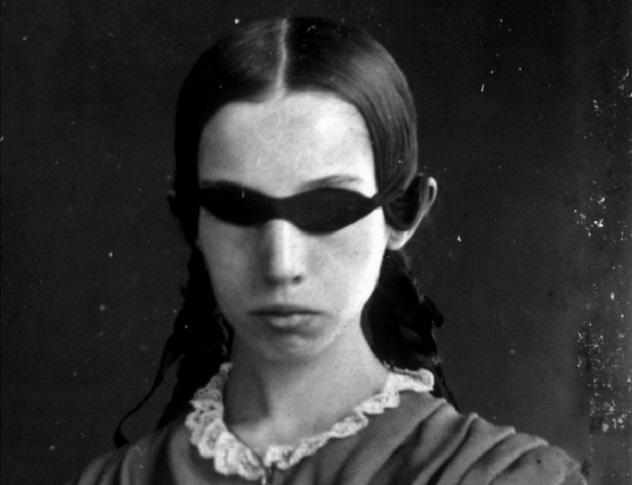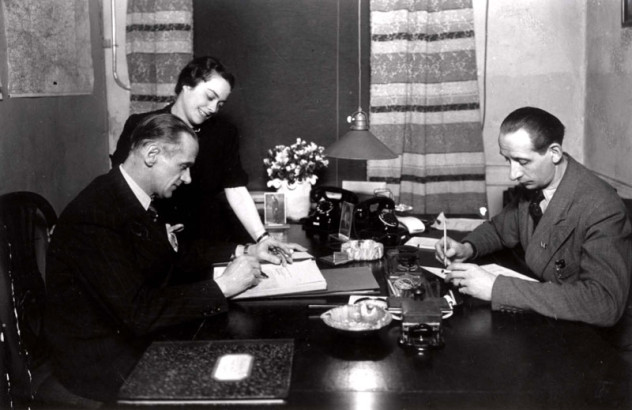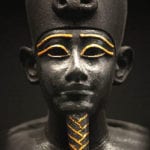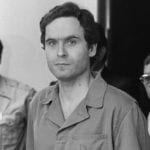 History
History  History
History  Pop Culture
Pop Culture 10 Cases of Grabbing Defeat from the Jaws of Victory
 History
History 10 Common Misconceptions About the Renaissance
 Weird Stuff
Weird Stuff 10 Crazy Things Resulting from Hidden Contract Provisions
 Facts
Facts 10 Unusual Facts About Calories
 Weird Stuff
Weird Stuff 10 Days of Humiliation When the Person Should Have Stayed in Bed
 Humans
Humans 10 Surprising Ways Game Theory Rules Your Daily Life
 Food
Food 10 Popular (and Weird) Ancient Foods
 Animals
Animals Ten Bizarre Creatures from Beneath the Waves
 Technology
Technology 10 Unexpected Things Scientists Made Using DNA
 History
History 10 Events That Unexpectedly Changed American Life
 Pop Culture
Pop Culture 10 Cases of Grabbing Defeat from the Jaws of Victory
 History
History 10 Common Misconceptions About the Renaissance
Who's Behind Listverse?

Jamie Frater
Head Editor
Jamie founded Listverse due to an insatiable desire to share fascinating, obscure, and bizarre facts. He has been a guest speaker on numerous national radio and television stations and is a five time published author.
More About Us Weird Stuff
Weird Stuff 10 Crazy Things Resulting from Hidden Contract Provisions
 Facts
Facts 10 Unusual Facts About Calories
 Weird Stuff
Weird Stuff 10 Days of Humiliation When the Person Should Have Stayed in Bed
 Humans
Humans 10 Surprising Ways Game Theory Rules Your Daily Life
 Food
Food 10 Popular (and Weird) Ancient Foods
 Animals
Animals Ten Bizarre Creatures from Beneath the Waves
 Technology
Technology 10 Unexpected Things Scientists Made Using DNA
10 Incredible Stories About Blind People
According to the World Health Organization, there were 39 million blind people on the planet in 2013. These are the people who wake up every day and stare down life without the help of their eyes. Truthfully, anyone who lives with this disability has an amazing story to tell, but some have achieved incredible things or had incredible things thrust upon them.
10The Blind Movie Critic
By its nature, film is a visual medium. You would think an art form intended primarily for the eyes wouldn’t interest a blind person, but you would be wrong. Not only does Tommy Edison watch movies, he reviews them on YouTube. Even though he was born without vision, Edison has always loved film, and when he started posting reviews three years ago, his videos attracted thousands of viewers. Even Roger Ebert gave Tommy two thumbs up.
Edison has given his take on everything from The Hunger Games to Reservoir Dogs, but he approaches movies differently from most film fans. “I’m not distracted by all the beautiful shots and attractive people,” he once said. “I watch a movie for the writing and acting.” Since he only judges what he can hear, Edison doesn’t care for CGI-heavy action blockbusters. On the other hand, he’s a big fan of Die Hard.
Even more fascinating than his reviews are the videos on his second channel, where he answers interesting questions from his viewers, such as how a blind person learns to smile, whether blind people can understand descriptions of color, and whether Edison would want to see if he was granted the ability. Simple yet profound, Edison’s personal vlogs give an amazing insight into the world of the blind.
Become a professional film critic with Five Stars! How to Become a Film Critic, the World’s Greatest Job at Amazon.com!
9The Soldier Who Sees With His Tongue
Craig Lundberg was a 24-year-old lance corporal serving in Basra, Iraq when his life changed forever. In 2007, the young soldier found himself on the wrong end of an RPG, receiving serious wounds to his head, face, and arms. Even worse, the attack left him completely blind. Doctors were forced to remove his left eye, leaving him with a right eyeball that was totally useless. Suddenly, Lance Corporal Lundberg was lost in the dark.
Lundberg was prepared to spend his life relying on his guide dog when he was chosen by the Ministry of Defense to test a crazy piece of sci-fi technology called the BrainPort. After donning a pair of sunglasses equipped with a video camera, images from the camera were converted into electrical pulses and sent to the “lollipop,” a device sitting on Lundberg’s tongue. Scientists aren’t sure what happened next—the signals coursed through his tongue and ended up either in the visual cortex or the somatosensory cortex (the part that processes touch). Either way, Lundberg could now see—sort of.
While the lollipop felt like “licking a nine-volt battery,” Lundberg could suddenly make out two-dimensional images. He could identify simple shapes, didn’t need help moving, and could pick up objects without fumbling around. Even more surprising, he could make out letters, giving him the ability to read. While the device is still in development, it promises to give Lundberg a completely new life, although he says he’s never getting rid of his faithful guide dog.
8The Explorer Who Trekked To The South Pole

We’ve already told you about Erik Weihenmayer, the blind adventurer who scaled Mount Everest, but he isn’t the only visually challenged superhuman laughing in Mother Nature’s face. Meet former Royal Navy sailor Alan Lock. Growing up, Lock dreamed of becoming a submarine officer, but during training, he lost his eyesight in six short weeks to macular degeneration. Lock views the world through “frosted glass with blind spots” dotting his vision, but he wasn’t going to let a little thing like blindness bring him down. Inspired by his disability, Lock set out to conquer the world.
Between 2003 and 2012, he competed in 18 marathons, climbed Mount Elbrus, and became the first blind person to row across the Atlantic Ocean. Still not satisfied with his list of awesome achievements, Lock decided to try something even cooler—literally. With the help of two sighted friends and a guide, the 31-year-old set off from the Antarctic coast, determined to ski to the South Pole. Hauling a 60-kilogram (130 lb) sled around his waist and battling freezing winds, Lock and his companions traveled 960 kilometers (600 mi) over 39 days, snacking on dehydrated foods and chunks of butter. Not only did he became the first blind person to reach the South Pole, he earned over $25,000 for charities that help the visually challenged.
7The Blind Woman Who Can See Movement
In 2000, 29-year-old Milena Channing suffered a stroke that wiped out her primary visual cortex. This should have left her completely blind, but Channing swore she saw rain as it fell to Earth. She saw cars whizzing past her window and even saw her daughter running and playing. When doctors analyzed Channing’s brain, they thought she must have been mistaken. It was neurologically impossible for her to see anything other than a big, empty void. They believed she may have been suffering from Charles Bonnet Syndrome, a bizarre affliction that causes blind people to experience hallucinations.
Convinced these flashes were real, Channing met up with Gordon Dutton, the only physician who believed her story. The Glasgow ophthalmologist suspected Channing was instead experiencing Riddoch’s phenomenon, a strange syndrome that allows people to see moving shapes but nothing else. To test his theory, the doctor had Channing sit in a rocking chair and move back and forth. Suddenly, she could see the world moving past her.
Sure enough, five years after the stroke, a group of researchers confirmed that the part of Channing’s brain that processed motion was still intact. Instead of sending signals to her visual cortex, her eyes were routing information to the region in charge of interpreting movement. Fortunately, with the help of Dr. Dutton, Channing has slowly started seeing things more clearly. She still cannot make out the faces of those around her, as the part of her brain dedicated to that process no longer functions, but the fact that she can see anything at all is nothing short of amazing.
6The Painter Who Can’t See His Own Art
Born in Istanbul in 1953, Esref Armagan had two strikes against him before he even took his first breath. Not only was his family poor, his eyes were completely worthless. One was the size of a lentil, while the other just didn’t work.
Despite his bad breaks, Armagan was a curious kid. Wanting to explore, he started touching everything he could get his hands on, and eventually, he started drawing. Starting at age six, he eventually graduated from butterflies and colored pencils to portraits and oil paints. Working in total silence, Armagan visualizes an image and then makes an outline with a Braille stylus. Next, he traces the etching with a pencil, checking his work with his sensitive left hand. Afterward, he uses his fingers to dab on the paint until he has a windmill, a villa, or even a Volvo.
In 2009, the Swedish car company hired Armagan to paint their new S60. After tracing the car’s outline with his fingers, he whipped up a rather impressive painting, especially considering he couldn’t see his subject. In addition to commissioned work, Armagan’s paintings have shown up in the Netherlands, the Czech Republic, the US, and China. He’s even appeared in an episode of Discovery’s The Real Superhumans.
However, the strangest thing about Armagan is his very unusual brain. Harvard researchers asked the Turk to draw a few sketches from the inside of an MRI scanner. As Esref doodled away, scientists were shocked by what they saw. Usually, a blind person’s visual cortex shows up in scans as a black blob. That’s what Armagan’s looked like when he wasn’t drawing, but when neurologists gave the artist a pen and paper, his visual cortex lit up like a Christmas tree. It looked like he was using his eyes. Scientists are still trying to figure out Armagan’s mysterious brain, but whatever is happening in his head, it’s working wonders on his canvases.
Discover how some of these people can do such incredible things with The Body Has a Mind of Its Own: How Body Maps in Your Brain Help You Do (Almost) Everything Better at Amazon.com!
5The Man Who Hacked The Phone System

Joe Engressia was a very “phreaky” guy. Born blind in 1949, this precocious kid spent his days playing with phones, calling random numbers, and listening to recordings for fun. It was the only way a visually challenged geek could entertain himself back in the ‘50s. He was also one of those kids who enjoyed whistling, and it was the combination of these weird hobbies that led Engressia to discover the secret world of the telephone system.
When he was just eight years old, Engressia was making a call and whistling when the recording suddenly stopped. He tried it again and realized that whenever he whistled at 2,600 Hz, the message would cut off. Thanks to his songbird powers, he could fool the tone-based system into thinking he was an operator. From there, the possibilities were endless. He could place long-distance calls for free or chat with multiple people on conference calls. Eventually, he got so good that he routed a call all the way around the globe and back to himself on a separate receiver.
Obviously, this was very illegal, and Engressia was arrested twice. Instead of scaring him straight, though, the notoriety thrust him into the center of a bizarre subculture. As it turned out, Joe wasn’t the only one to figure out the phone lines. In the 1970s, “phreaking” (the term for tinkering with the phone system) was a regular hacker activity, and Engressia became one of their leaders. Some of these tech-savvy kids, like Steve Jobs and Steve Wozniak, went onto greatness. Engressia, on the other hand, wasn’t so lucky.
Though he had an IQ of 172, a rough home life coupled with sexual abuse by a teacher totally messed with his mind. During his later life, Engressia changed his name to “Joybubbles” and insisted he was five years old. Joybubbles listened to Mr. Rogers tapes religiously, collected toys, talked to imaginary friends, and lived off Social Security checks. Sadly, Engressia passed away in 2007, leaving behind an impressive but depressing legacy.
4The Inventor Who Created Cruise Control

Anyone who’s ever driven a car owes a debt of gratitude to Ralph Teetor. During the 1940s, he invented one of the most useful features in your automobile: cruise control. That’s extremely impressive, considering that Teetor went blind at age five. He lost his vision in a shop accident, but that didn’t stop him from tinkering and building things.
In fact, it gave him an edge that sighted inventors lack. Not only could he better concentrate on his tasks, he wasn’t constrained by what his eyes told him was standard or acceptable. He was free to create whatever he saw in his mind, and he created quite a few cool things in his day. In 1902, the 12-year-old built a car out of spare parts. After graduating from the University of Pennsylvania in 1912, he developed a new kind of fishing rod and reel, a locking mechanism, and a method of balancing steam turbine rotors in torpedo boat destroyers.
Eventually, he opened his own corporation, which specialized in piston rings, but his greatest achievement came during World War II, when he was riding in a car driven by his lawyer. As the story goes, the attorney couldn’t talk and drive at the same time. Whenever he started talking, he eased off the breaks. When he stopped, he stepped on the gas. This erratic driving quickly nauseated his blind passenger. Frustrated with his friend’s inability to drive, Teetor came up with the concept of cruise control. Ten years later, he was applying for a patent, and soon after, it started showing up in Chrysler automobiles. Today, nearly every car on the road has cruise control, all thanks to a blind inventor and a lousy driver.
3The Most Famous Blind Girl In The World

Have you ever heard of Laura Bridgman? There was a time when she was one of the most famous people on the planet. Born in 1829, Bridgman lost four of her five senses at age two after a bout of scarlet fever. Left only with the sense of touch, the young girl ended up at the Peterson’s Institute in Boston, an asylum run by a man named Samuel Gridley Howe. While he was an unpleasant person, Howe was fascinated with Bridgman’s case, and by her seventh birthday, he had taught Laura how to communicate with the outside world.
Forty years before Helen Keller was even born, Bridgman was learning to form letters with her fingers and press the shapes into a receiver’s palm, slowly spelling out words and sentences. She also learned to read by running her hands over raised type. Thanks to her hard work and Howe’s detailed reports, Bridgman became an international celebrity, attracting thousands of fans who clamored for her autograph and locks of her hair. People came from all around to watch her read and write, and little girls plucked glass eyes from their dolls, renaming them “Laura.” She even met Charles Dickens, who wrote about her in one of his books, making her even more famous.
Of course, life was still difficult for the young teen. As she grew older, she suffered from anorexia because she couldn’t taste or smell any food. She also became the center of a strange experiment. Curious what would happen if someone was cut off from all religious influence, Howe forbade anyone to speak to Laura about spiritual matters. When a group of evangelicals converted her to Christianity anyway, a furious Howe gave up on his pupil. He even went so far as to claim blind people were mentally inferior to the rest of the world. Disowned by her teacher, Bridgman spent the rest of her life living at the Perkins Institute, a forgotten figure abandoned by the world.
2The World’s First Blind Doctor

Jacob Bolotin holds a special place in medical history. The son of impoverished Polish immigrants, the good doctor was born in 1888 in Chicago. Unfortunately, congenital blindness ran in the family, and three out of the seven Bolotin children were born blind, including Jacob. Due to his disability, he quickly developed his other senses. Before long, he could recognize people by their scents and comprehend Braille through several layers of cloth.
After graduating from a school for the blind, Bolotin worked as a salesman, peddling brushes and typewriters on Chicago streetcars. His big dream was to become a doctor, but most colleges weren’t willing to accept a blind student. After relentlessly hounding university boards, he eventually made it into the Chicago College of Medicine. When he finally graduated at 24, he became the first congenitally blind person to become a licensed physician.
Bolotin’s specialty was studying diseases of the heart and lungs. Since he couldn’t see his patients, he relied on his fingers and ears to diagnose a patient’s ailments. During his internship at Frances Willard Hospital, he diagnosed a young woman with an obstructed heart valve just by feeling her skin and listing to her heartbeat. In addition to his medical work, he traveled across the Midwest giving lectures on blindness and started the first all-blind Boy Scout troop. Sadly, Bolotin passed away at age 36, but his funeral drew 5,000 people whose lives were touched by the blind doctor.
1The Blind Schindler

Otto Weidt hated the Nazis. As an anarchist and all-around good guy, he knew Hitler was trouble the moment the tyrant seized power. As Hitler’s anti-Semitic policies started playing out in the streets of Berlin, Weidt knew he had to act. Similar to the more famous Oskar Schindler, Weidt ran a shop that mostly employed Jews. The difference was that Weidt’s workers were all disabled. He regularly hired deaf, mute, and blind workers from the Jewish Home for the Blind and paid them to make horsehair brushes and brooms. Weidt knew what it was like to go through life without vision and wanted to help others who had the same problem.
Now that Adolf was calling the shots, Weidt had to defend his workers from the Gestapo. He first tried to convince officials that his employees were essential to the war effort. When that didn’t work, he resorted to bribery, giving away rare items like champagne, cigars, and perfume. Things became more difficult when the Nazis decided to exile the Jewish population of Berlin. Once the crackdown started, Weidt tried to hide his workers, but when a few were caught and dragged to a loading station, Weidt talked officials into letting them go right before the train took off.
On another occasion, a worker named Alice Licht was arrested and thrown into a cattle car bound for Auschwitz. Fortunately, she shoved a postcard through the floor, and the note made its way back to Weidt. Despite his blindness, he hurried to Poland and rented a safe house stocked with cash and clothing for the young woman. Weidt fell madly in love with Licht, but tragically, she left for America after the Reich fell and never saw her blind benefactor again. While no consolation for a broken heart, Weidt was posthumously recognized by Yad Veshem as “Righteous Among the Nations,” a non-Jew who risked everything to save his fellow man.
Nolan Moore would like to recommend this interview with author Beth Fenke on what it’s like to go blind. If you want, you can follow Nolan on Facebook or send him an email.








